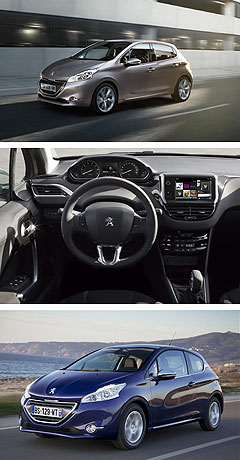Make / Model Search
Future models - Peugeot - 208208 evolves cabin ergonomicsComforting feeling: Peugeot's new 208 features improved ergonomics for better comfort and safety. Peugeot 208 offers drivers a better eyeline for improved safety and comfort25 Apr 2012 By BYRON MATHIOUDAKIS in PORTUGAL PEUGEOT hopes to start something of a minor ergonomic revolution thanks to what it says are small but effective safety, comfort and connectivity-related changes to the position of several vital interior controls. Due in the new 208 light car earmarked for a September release Down Under, the “ergonomic regeneration” is expected to spread to other near-future models like next year’s 308 small-car replacement known as the 301. Compared to the outgoing 207, the instrument cluster is higher up and closer to the windscreen, the steering wheel is smaller and placed lower down, and a new touchscreen protrudes prominently from the centre console. These measures are designed to enable the driver’s eyes to remain on the road longer. “It breaks the established codes to offer new driving ergonomics, clear, natural, benefiting ease of driving, maneuverability, precision ... a more intimate relationship with the vehicle, the feeling of being one with it,” claims Peugeot. Project manager for the 208, Jerome Micheron, said the company had shown “exceptional boldness” in incorporating the changes in the 208. “Deciding on completely rethought instruments and controls from the beginning of the project, on the model destined to be the marque’s biggest seller, was taking a huge risk,” he said. Interior designer Adam Bazydlo told GoAuto the aim was to minimise eye deviation from the road, so that everything the driver needs to see or glance at – from the speedometer to who may be calling on the newly integrated Bluetooth phone system – falls within a 20-degree ‘cone of vision’. He said one of the big benefits is a sizeable reduction in the amount of time the eyes are off the road reading instruments. “The 208 cluster now falls within the 20-degree cone of vision, which is the quality of peripheral vision because, at 50km/h, taking your eyes off the road for just one second equals 15 metres of ‘blind’ driving,” he said.  Referring to the 208’s raised instrument panel as a ‘Head Up Cluster’ – as opposed to a ‘Head Up Display’ that projects speed information onto a small area of the windscreen directly ahead of the driver – Mr Bazydlo said it is just 11 degrees offset of the driver’s eye line, compared to the 207’s 17 degrees. Referring to the 208’s raised instrument panel as a ‘Head Up Cluster’ – as opposed to a ‘Head Up Display’ that projects speed information onto a small area of the windscreen directly ahead of the driver – Mr Bazydlo said it is just 11 degrees offset of the driver’s eye line, compared to the 207’s 17 degrees.The ideal HUC position meant that the steering wheel not only had to have a smaller diameter, but also needed to be set lower, in order for its rim not to obscure important instrumentation information. “So we placed all the vital data in the upper areas of the instruments,” he said. “Most cars have the outer part of the steering wheel covering at least part of their instruments.” He said one of the unexpected advantages of moving the wheel down is better blood flow from having the driver’s arms down closer to the heart, further reducing strain and fatigue. “The normal wheel/hand relationship forces the arms up and the seat down, creating blood flow issues and fatigue,” said Mr Bazydlo, adding that Peugeot’s research has found that in most situations drivers immediately drop their seat and raise the steering wheel. “That’s why so many people naturally hold the wheel down at its base after a long journey. They get tired.” Mr Bazydlo is confident other manufacturers will follow Peugeot’s lead. “I’m interested how other carmakers will respond to this enhancement,” he said. “There have been vehicles with a HUC-style display, but it’s been in the centre of the dash, or never close to the windscreen, and never in conjunction with a smaller steering wheel. “We have had many people drive a 208, then back to a 207, and their response is incredible … (the old car) feels like driving a tractor wheel. People will forget about their old habits.” In order not to alienate more traditional Peugeot buyers, the 208’s interior stylists have included a few classic cues to help make them feel at home. “There was a certain spirit around the 205 and 206 that we tried to recuperate and repackage into the 208,” said Mr Bazydlo. “These two old cars have a great feeling that represented something, so we tried to bring it back, not in a retro way but in the squareness of the instrument cluster and dash, for example.  Read more25th of April 2012  208 shows softer side of PeugeotFrench engineers cut weight to develop a softer-riding and better-handling 208All future models208 pricing
Motor industry news |
Click to sharePeugeot modelsResearch Peugeot All future models208 pricing
Motor industry news |



 Alfa Romeo
Alfa Romeo Abarth
Abarth Audi
Audi Aston Martin
Aston Martin BMW
BMW Bentley
Bentley Ferrari
Ferrari Chevrolet
Chevrolet Ford
Ford Fiat
Fiat GWM
GWM Foton
Foton Hyundai
Hyundai Honda
Honda Jaguar
Jaguar Isuzu
Isuzu Kia
Kia Jeep
Jeep Land Rover
Land Rover Lamborghini
Lamborghini Maserati
Maserati Lexus
Lexus McLaren
McLaren Mazda
Mazda Mercedes-Benz
Mercedes-Benz Mitsubishi
Mitsubishi Mini
Mini Peugeot
Peugeot Nissan
Nissan Ram
Ram Porsche
Porsche Rolls-Royce
Rolls-Royce Smart
Smart Skoda
Skoda Suzuki
Suzuki Subaru
Subaru Toyota
Toyota Tesla
Tesla Volvo
Volvo Zeekr
Zeekr







Facebook Twitter Instagram